The Week in Estate Jewelry: Tiger Claws, Secret Hearts, and Opal Madness
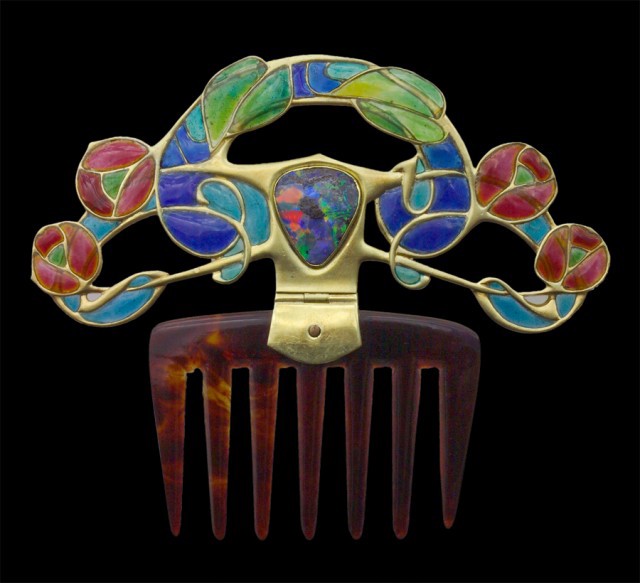
Archibald Knox (1864–1933) was one of the giants of the British Arts & Crafts and Art Nouveau design movements, and his history is deeply intertwined with that of Liberty & Co., the great English department store. He was particularly known for his Celtic-style designs, which he first developed as a student on the Isle of Man.
Arthur Lasenby Liberty, meanwhile, founded Liberty & Co., in 1875. Arthur Liberty was a great believer in the central Arts & Crafts tenet that quality design can still be achieved at low cost. He filled his store with ornaments and fabric from the Far East, and commissioned work from many of the English designers of the period, quickly attracting a fashion-forward clientele that included members of the Pre-Raphaelite Brotherhood. His championing of contemporary designers resulted in the store becoming synonymous with the Art Nouveau movement, and his stock expanded to include furniture, clothing, jewelry and wallpaper. (Liberty & Co is still around today, and well worth a visit if you’re in London!)
Knox began designing for Liberty around 1899, and his Celtic style is particularly seen in the “Cymric” and “Tudric” lines he made for them in silver and pewter. The flowing, intertwined lines of his Celtic style merged well with the Arts & Crafts and Art Nouveau styles, as they combine sinuous natural motifs with harmonious gemstones and enameling.
This Knox comb/diadem dates to 1900, and was created for Liberty. It features a central opal surrounded by intertwining flowers and foliage, all executed in plique-à-jour enamel in colors that mimic those found in the opal. The piece is set in gold, and the reverse of the comb features an embossed butterfly design. The comb is hinged, so that it can also be worn straight on as a diadem (or crown).
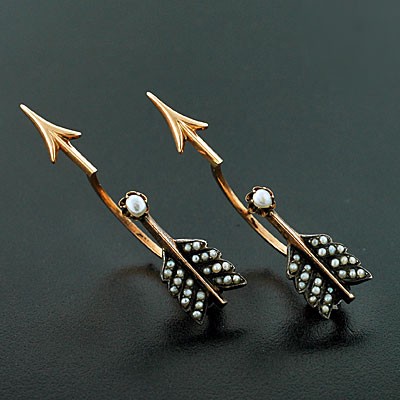
Circa 1930, a pair of late Art Deco arrow earrings in 14k rose gold with seed pearls.
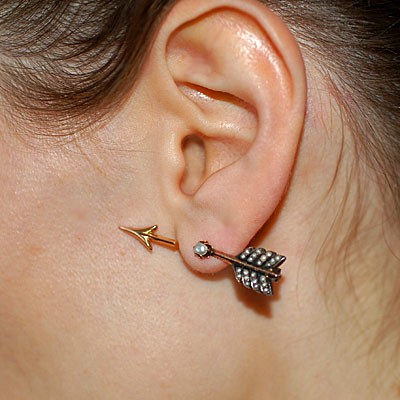
There’s a hinge hidden underneath the feathers that allows the earring to open up so that the post can be inserted into the ear, giving the illusion that the arrow has penetrated through and is emerging on the other side. (Ed. note: GASP.)

I’m not usually drawn to more modern jewelry, but I love the brightness and simplicity of this 1970 Cartier bracelet. It’s made of gold and features gorgeous loose discs of lapis and carnelian.
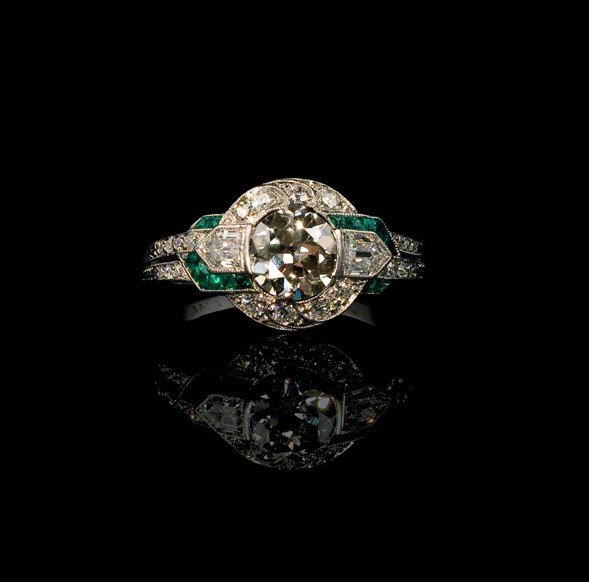
Circa 1925, an Art Deco ring by Tiffany & Co., featuring emeralds and diamonds set in platinum.
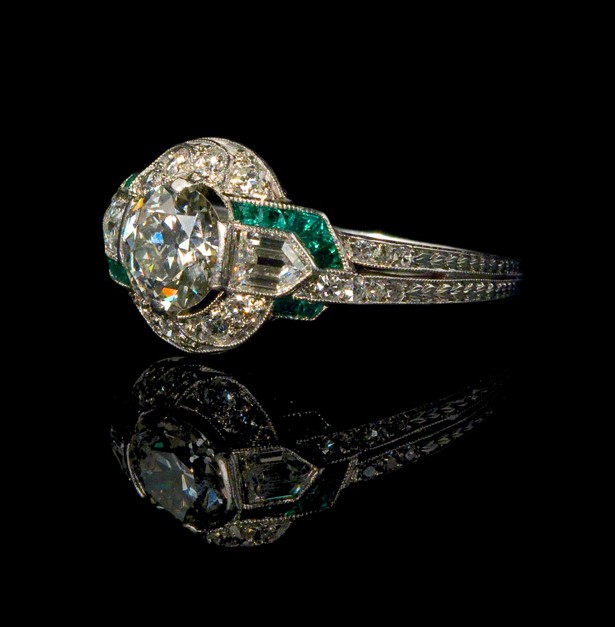
Drool.
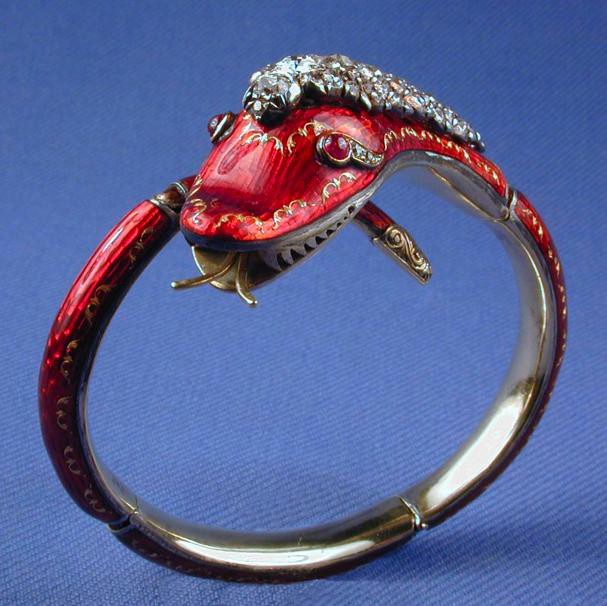
“Hey baby, how ’bout you and I shed some skin?”
Circa 1850, this gold snake bangle with diamond accents and red guilloché enameling is hinged in four places. Its eyes are ruby and the diamonds on the head are apparently a “flame motif,” but dude, that’s totally a hairpiece.
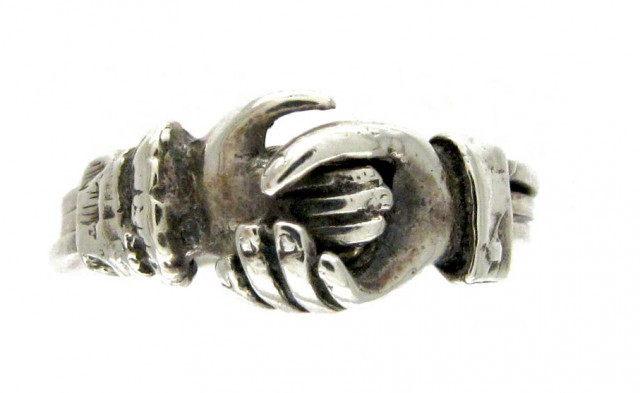
For all of you who like secret message jewelry, you’ll love this. This is a called a “gimmel” ring. The term “gimmel” comes from the Latin gemellus, or “twin,” and gimmel rings usually feature two or three hoops or links that fit together to form one single ring.
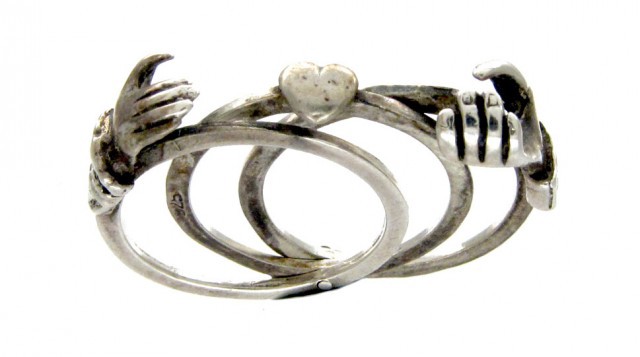
They’re closely related to “fede” rings, which take the form of two clasped hands, and were used as betrothal rings for centuries dating back to antiquity. The central heart motif started to make an appearance in designs around the 16th century (you’ll also recognize this imagery in claddagh rings), and the style continued to be popular through the 19th century. This ring is a lovely Victorian example.
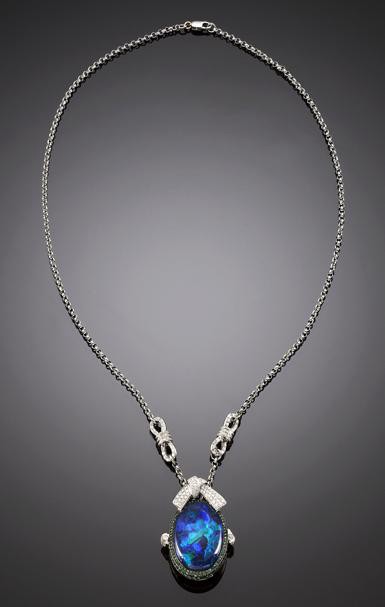
I mentioned the Parisian jewelry house Mauboussin last time, and here they are again, just on the merit of this stunning 22.63-carat Australian black opal.
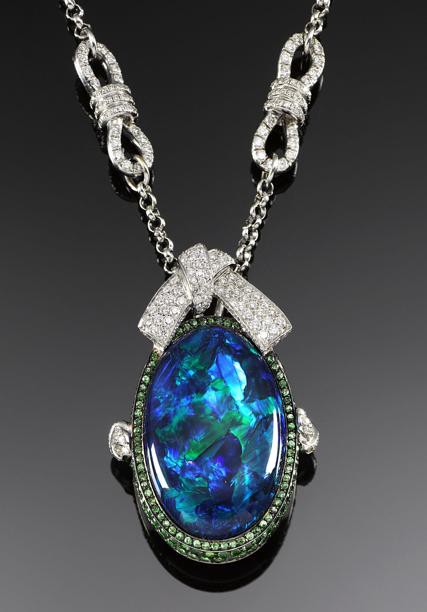
Accented with 2.50 carats of tsavorite garnets and 1.50 carats of diamonds (all set in 18k white gold), that opal is amazing. Mauboussin has always been known for a particular expertise in colored stones, and this piece really allows you see the artistry in gem-setting and jewelry design, as the garnets perfectly complement and draw out the green within the opal.
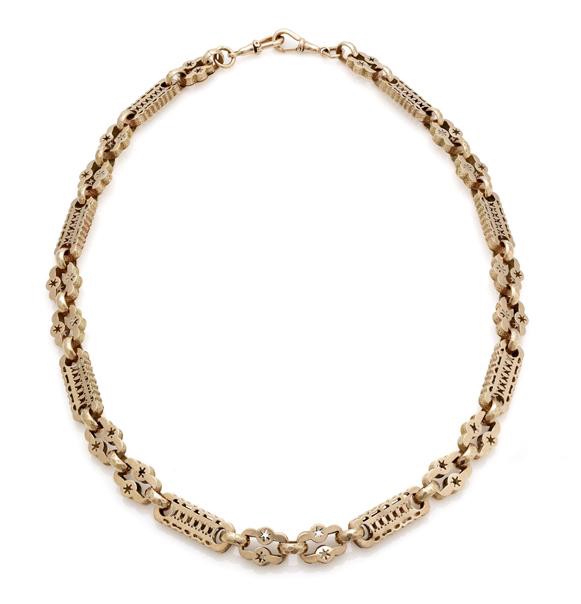
Circa 1890, this is a very pretty late-Victorian openwork link chain in 9k rose gold with engraving. It’s an Albert chain, which is a type of watch chain that, according to the dealer, “contains a swivel on at least one end that gets threaded through the buttonhole of a waistcoat, sometimes secured with a toggle bar.” You often see them in old images of barrel-chested Victorian and Edwardian men, threaded from pocket to pocket across the front of the man’s vest.
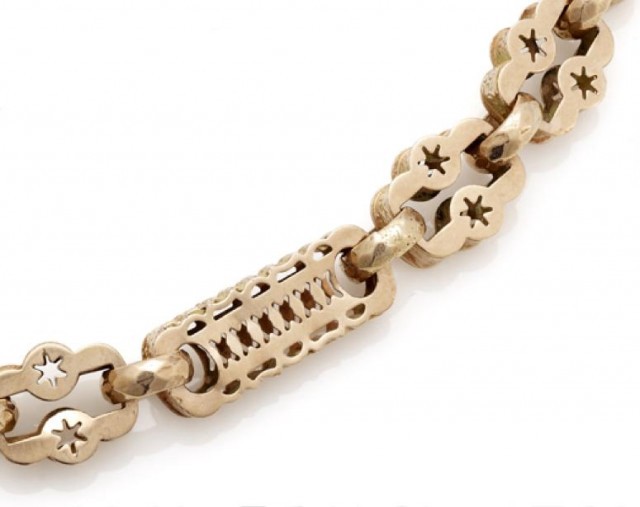
I actually want to take this opportunity to give some props to rose gold … If I had a dollar for every time a pale-skinned woman complained to me about how awful yellow gold looks against her skin, I could probably buy this chain. And I know; I hear you! I have a death-approximating complexion myself, and as a result I also went through a silver/white gold period — until I discovered rose gold. Pure gold is very soft, so it needs to be alloyed with another metal to gain strength, and, depending on the metal used, the color of the gold can be altered. There are actually lots of different colors of gold out there — green, black, gray, even purple! But rose gold, which combines gold with copper to create a soft, pinkish hue, is a very understated, flattering color for us pale girls. Give it a shot!
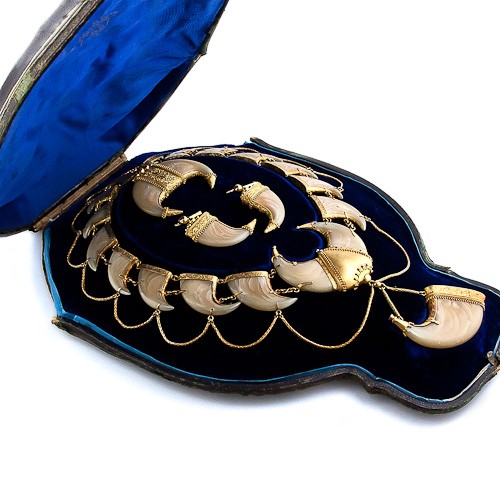
Way back in the day, I told you guys about Bengal tiger claw jewelry, and how it was manufactured by native craftsmen for the English tourist market in India during the late 19th century. Most of the time you’ll see single pieces — pendants, brooches, sometimes earrings — but this set is insane. It’s a parure — a.k.a. a suite of matching jewelry; in this case a necklace, earrings, and a brooch — consisting of 22 tiger claws set in engraved 18k gold and finished in the Etruscan style popular to the time. I find the entire thing completely horrifying, but it’s an interesting window into Victorian society: It would certainly have been owned by an exceptionally wealthy woman, and it was meant to dazzle onlookers. The set comes in its original box from Halton & Slocombe Goldsmiths & Watchmakers in London, so I wonder if this suite was a custom design, the result of a hunting trip? It’s just SO ostentatious, so calculated for showing off … Or, alternately, it might simply have been an exported item. I don’t know; it’s all speculation. The necklace is also engraved “May 25th 1883” on the reverse of the central double claw. Ugh.
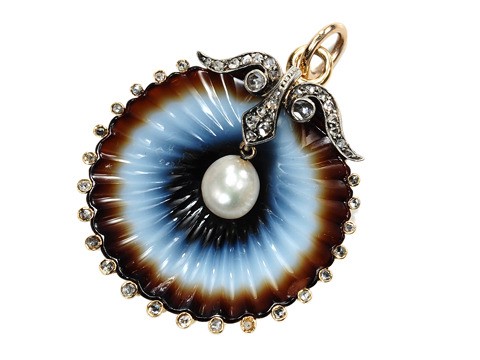
This banded agate pendant is just so pretty I had to include it. Banded agate is a kind of chalcedony that naturally occurs in various kinds of rocks, many of them volcanic. It features different layers of color and is extremely strong, so it’s an ideal candidate for carving, and has been used for centuries both in design and industry.
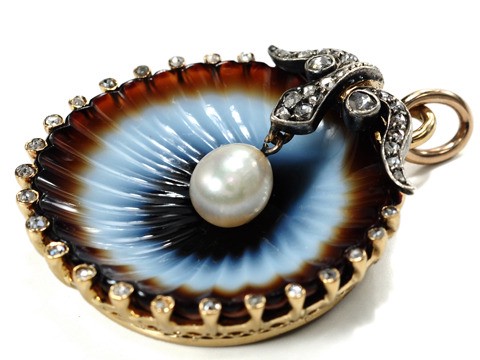
In this particular piece, the designer has skillfully carved down through the various bands of color to mimic the color-shifts of a seashell, and then surrounded the stone with a frame of 17 rose-cut diamonds and a central natural pearl, all in 14k yellow gold. (Circa 1880.)
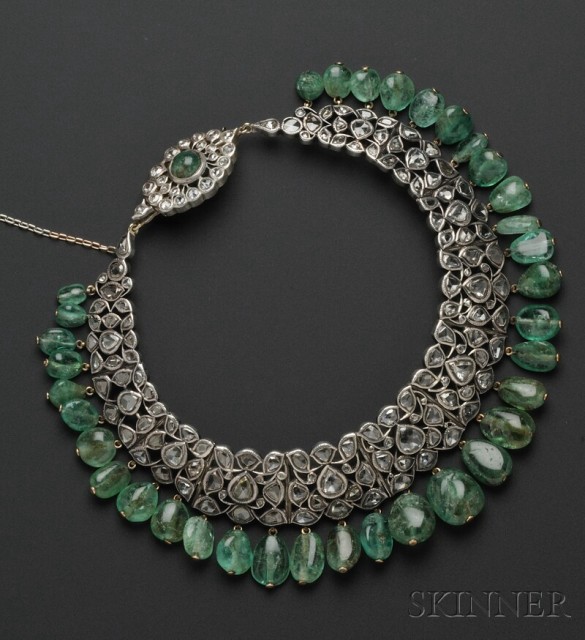
There are a couple jewelry auctions coming up in the next few weeks, allowing for some great online catalog browsing. First up, on September 13, is Fine Jewelry at Skinner, Boston, featuring (among other things) this amazing diamond and emerald collar-style necklace, with rose-cut diamonds and 35 emerald bead drops. GAH.
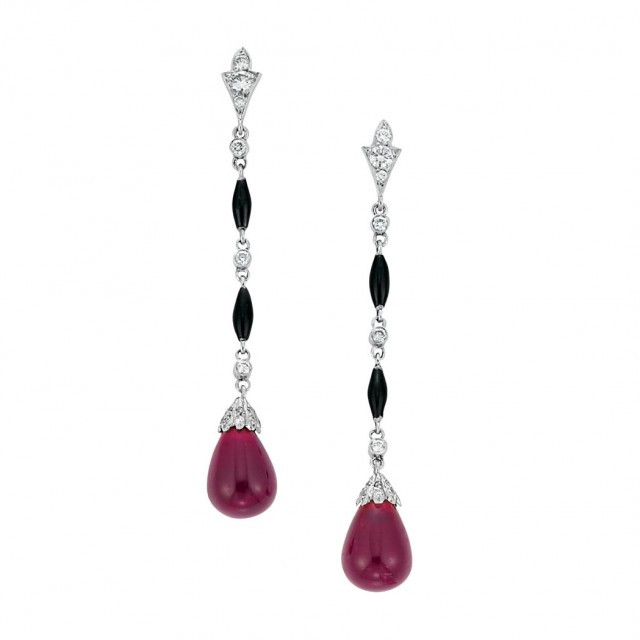
Then, on September 21, we have Important Estate Jewelry at Doyle New York. Check out these platinum, diamond, onyx and rubellite earrings. Beautiful.
Previously: Snakes, Bears, and “I Like My Choyce.”
Monica McLaughlin is ridiculously amused and delighted at the thought of being hit on by a louche snake with a hairpiece.